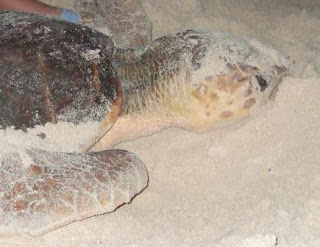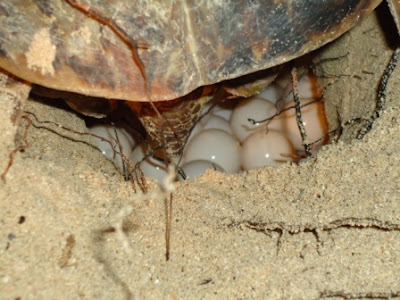So what’s a turtle all about? I thought I would share a couple special stories from our first few weeks of nights on the beach. We’ve been getting hawksbills and greens almost exclusively, but there is one loggerhead female hanging around Buck Island and nesting every few weeks. I’ve included a picture of her here—check out that head! They eat large mollusks and so need a huge, thick beak and heavy jaw muscles, resulting in a much broader head than other turtle species. It’s rare for loggerheads to nest in the Caribbean, making this lady’s visits that much more special.
 |
| Loggerhead |
 |
| Green |
As I think I’ve mentioned before, hawksbill turtles are very quick animals, both in their nesting habits and in their movements on land. They can emerge from the ocean, nest and leave the beach in as little as 45 minutes, making it a challenge for us to get to them in time and get everything done. There are, of course, anomalies such as the hawksbill that spent 3 hours searching for a suitable nesting site! One member of our team waited patiently for this girl while she body pitted here and there and actually ended up in the first spot she abandoned several hours before. Who knows what goes on in a turtle’s brain?
Then there was the hawksbill that was already finishing nesting when we found her. Remember, they're fast! There are several main stages to a nesting activity. First, a turtle emerges from the ocean and crawls up the beach until it levels out. She settles on a spot when she realizes that her body is horizontal and no longer climbing upslope. Then she clears the area of vegetation and the surface layer of sand with her front and hind flippers, creating a body pit (relatively small for hawksbills, much larger for greens). If she likes the area, she will start to dig her nest hole with just her hind flippers, which is an incredible process. She reaches into the hole with a flipper and cups out the sand, flings it out of the way, and does the same thing with her other flipper until the hole is of sufficient depth. But if she hits roots or rocks she’ll likely abandon the nest hole. This is something we call ENL – Emerge No Lay. Sometimes a turtle will move and try her hand at digging a nest hole in a new spot. Sometimes she’ll head straight back to the ocean. Often, a turtle will ENL several times a night, or for several nights in a row, before laying. If a turtle ENL’ed the night before, you can almost certainly expect her back the nest night. If she does decide to lay her eggs, which usually takes about 15-20 minutes, then she’ll carefully cover the hole and camouflage the whole area so predators don’t find her nest.
Getting back to the story, this little hawksbill was camouflaging by the time we got to her and buried underneath a big grove of sea grape, a woody tree-shrub that’s relatively friendly compared to some other Buck Island vegetation. The major goal of our project is to give every turtle that comes on the beach an identity and we do this with flipper tags with unique numbers. We couldn’t find a tag on either of her hind flippers and needed to check her front ones, but she was ready to head back to the ocean. I crawled deep under the sea grape and was trying to get her turned around enough to check her flippers but she wasn’t having it! When a 150-pound turtle decides she’s going somewhere, there’s not a lot you can do to stop her. So we modified the plan and decided to get between her and the ocean and intercept her when she left the sea grape. This worked like a charm but it wasn’t easy. She burst from the vegetation, and I had to grab her by the front and back of her shell and try to flip her around so she faced away from the ocean, then sit on her and attempt to hold her down while my crewmate read her tag. We got it done and emerged with just a few scrapes and bruises, which is really nothing. One of my crewmates was literally run over by a turtle! If a turtle ENL’s and is heading back to the water, you can sometimes lie down in front of her and pretend to be a log. If you can get her turned around she might go back up the beach and try to lay again. So he tried this, but instead of going around him she decided to go right over, even pausing on top to take a deep breath before continuing on her way!
Stay tuned for more exciting turtle stories from the next night on the beach!







